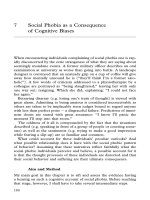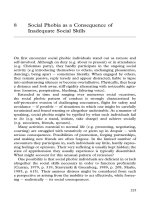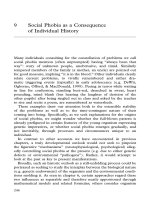Social factors as a basis for treatment
Bạn đang xem bản rút gọn của tài liệu. Xem và tải ngay bản đầy đủ của tài liệu tại đây (103.54 KB, 16 trang )
11
Social factors as a basis for treatment
Richard Warner
Introduction
Service delivery programmes in psychiatry are usually developed as a solution to a
specific problem. Assertive community treatment, for example, was devised by Stein
and Test (1980) as an answer to the hospital revolving-door problem that resulted
from the radical deinstitutionalisation that took place in the USA in the 1960s. The
psychosocial clubhouse was developed as a solution to the boredom and social
exclusion that many people with mental illness experience when they achieve a stable
existence in the community (Beard et al., 1982). The specificity of the programme
models as solutions to contextual problems explains why different psychosocial
treatment models have been successful in different systems of care at different times.
For this reason, it is useful to explore how social difficulties have led to different
treatment and rehabilitation solutions, and how they might lead to new treatment
approaches in the future. Let me list some of the social problems that people with
mental illness confront:
Unemployment Only 10–20% of people with serious mental illness in most
Western countries are employed (Marwaha and Johnson, 2004).
Poverty Most people with mental illness must survive on disability
benefits, below the poverty level.
Homelessness The proportion of people with psychosis among the homeless
in Britain and the USA varies depending on the population
selected, but ranges around 10–30% (Warner, 2004).
Incarceration The proportion of those in jail who suffer from a psychosis
in Britain and the USA is around 10%, and, in Britain, is
increasing (Warner, 2004).
Isolation Many people with mental illness have few social contacts or
supports.
Powerlessness The lack of control over many aspects of their lives worsens
the course of illness for people with mental illness.
Society and Psychosis, ed. Craig Morgan, Kwame McKenzie and Paul Fearon. Published by Cambridge
University Press. # Cambridge University Press 2008.
Stigma People with mental illness are subject to stigma and discrim-
ination in hiring, accommodation and participation in the
larger community (see Chapter 12).
Many programmes have been developed or proposed to solve these problems. To
illustrate these, this chapter will focus on unemployment, poverty, homelessness,
incarceration and isolation (see Chapter 12 for a discussion on stigma).
Unemployment
For many people with mental illness, and their friends and family members, work is
a fundamental measure of recovery. A job can bring increased income, expanded
social contacts and a sense of meaning in life, while unemployment carries risks of
alienation, apathy, substance abuse, physical ill-health and isolation (Bond, 2004;
Warr, 1987). In recent decades, however, rates of employment for people with
psychosis enrolled in treatment in the USA and most European countries have rarely
exceeded 10–20% (Marwaha and Johnson, 2004). Over the years, there have been
several obstacles to employment for people with mental illness – periods of high
general unemployment; ineffective vocational rehabilitation programmes; disin-
centives to employment fostered by disability pension systems; and the stigma of
mental illness, leading to hiring discrimination. People with mental illness them-
selves may hold back from working, or family members or therapists may discour-
age it. The stereotype of schizophrenia breeds the assumption, accepted even by
those afflicted with the illness, that work is not feasible. In a sample of Colorado
residents with schizophrenia interviewed by me in 2005, 84% reported that they had
held back from applying for work because of their diagnosis, 50% to a great extent.
Disincentives to employment
Fifty to sixty percent of people with psychosis are capable of work in the com-
petitive workforce, as evidenced by various observations. In northern Italian cities
in the mid-1990s, 50% or more of people with schizophrenia were working,
20–25% of them full-time (Warner et al., 1998). This is due, in part, to the fact
that Italian disability benefits impose fewer work disincentives. In studies of
supported employment programmes for people with serious mental illness in
the USA, moreover, 50–60% of participants routinely achieve competitive employ-
ment. In a recent study in Chennai, India, 67% of people with chronic schizo-
phrenia were employed, mostly in mainstream jobs (Srinivasan and Tirupati,
2005), and in another 20-year follow-up of men with schizophrenia in Madras
(now Chennai), 76% were employed (Thara, 2004). Clearly, it is not psychosis
per se which imposes high rates of idleness, but the economic system. People with
mental illness in the developed world face significant financial disincentives to
164 R. Warner
work if they are receiving disability benefits (Rosenheck et al., 2006; Warner,
2000). These disincentives are more severe in Britain and the USA than in Italy,
with the result that a much smaller proportion of people with mental illness are
employed in these English-speaking countries.
Disability pension systems can be designed to minimise disincentives. In the USA
there are two major governmental disability support programmes – Supplemental
Security Income (SSI) and Social Security Disability Income (SSDI). Under
both programmes, support payments decline when people accept employment.
Recipients of SSI lose 50 cents of benefits for each dollar earned when earnings
exceed a small amount. Recipients of SSDI lose nothing until they earn a much
greater amount, but then lose it all. In practice, SSDI creates fewer disincentives to
work, as recipients continue to collect the full benefit as long as they don’t earn too
much.
In Britain, disincentives are worse, as disabled people run the risk of losing all
their incapacity benefit if they earn more than a small weekly amount, and an
earnings disregard is permitted for only a few months. Since a full benefits package
is worth significantly more than a full-time minimum-wage job, there is little
financial incentive for the psychiatrically disabled in Britain to work part-time or
full-time (Grove et al., 2004). Attempts have been made to alleviate disincentives
in the UK. One measure allows a person to retain benefits if the job ends within a
year, and another tops up incomes for those who earn only a little. Nevertheless,
fewer than 5% of those receiving incapacity benefit for two years return to the
labour market (Grove et al., 2004).
In Italy, work disincentives are less severe than in the USA or Britain because (1)
fewer people with mental illness qualify for benefits and (2) Italian disabled people
often manage to retain benefits while working. The Italian disability pension is
substantially lower than in Britain, but this is not the critical issue – to receive the
benefit the person must be 80% disabled (Fioritti, 2004). A system like this is only
possible because 80–90% of Italians with psychosis are living with, and being
supported by, their families (Warner, 2000). The lack of formal income support
for many people with mental illness increases the incentive to make use of the work
opportunities, which are often quite comprehensive, for people with mental illness
in Italy, especially in the north. Beyond these formal system features, however,
many Italians who receive disability benefits continue to work in the ‘black market’
labour force – along the beaches in summer and on family farms (Fioritti, 2004).
Econometric labour-supply models (Moffit, 1990) can forecast the effects of
changes in benefits policy. Averett et al. (1999) gathered economic information
from over 200 people with psychosis in Colorado and examined the result of
modifying SSI regulations. The model revealed that increasing the earnings dis-
regard or offering a wage subsidy led to increased hours of work.
165 Social factors as a basis for treatment
A simpler answer is to advise clients about the remedies that are already in place to
ease disincentives. Grove et al. (2004) report success in Britain with the use of
personal advisors who provide clients with information about return-to-work
benefits. Tremblay and colleagues (2006), in the USA, demonstrated that people
with psychiatric disabilities who were provided with benefits counselling improved
their income by $1250 a year more than control subjects. Where benefits counsellors
are not available, case managers can be trained to understand benefits regulations
well enough to help clients make good decisions about work and income.
Supported employment
Vocational programmes were unsuccessful in improving long-term employment
outcomes for people with psychosis until the 1970s (Bond, 1992; Lehman, 1995).
Traditional ‘train and place’ vocational services designed for people with physical
disabilities have proven ineffective for people with serious mental illness (Noble
et al., 1997; US General Accounting Office, 1993), but, in the 1970–80s, vocational
programmes designed for people with psychiatric disorders were successful in
placing clients in sheltered jobs or transitional employment positions, and in
helping them hold down those jobs. With the introduction of supported employ-
ment in the 1990s, competitive, mainstream employment became a viable option
for people with mental illness.
Transitional employment programmes (TEPs), developed in the 1970s, were the
precursors of supported employment. In a TEP, a job coach locates a job in a local
business, learns how to do it, trains a client with mental illness and places him or her
in the position for a limited period, usually six months. The worker is supported on
the job by the coach and can attend weekly support meetings. If the disabled person
cannot work for any reason the job coach will find someone else to work that day.
The principle behind TEP is that the disabled person learns basic job skills in a
transitional position that will help him or her get a permanent, unsupported job in
the competitive marketplace. In fact, research does not support the belief that TEP
workers are more likely to secure competitive employment (Lehman, 1995). For the
person with a mental illness, a supported employment model – similar to the TEP
approach except that the job is permanent – is more suitable.
A refinement of the supported employment model has been named individual
placement and support (IPS). Bond has outlined several evidence-based principles
of this approach (Bond, 1998; Bond, 2004):
*
Eligibility is based on consumer choice. No clients are excluded because of a
poor prior work record, or lack of ‘work readiness’. People with mental illness
have better outcomes in supported employment regardless of diagnosis, sub-
stance abuse or prior frequency of hospitalisation (McGurk and Mueser, 2003;
Sengupta et al., 1998).
166 R. Warner
*
Integration of vocational rehabilitation and mental health services. Supported
employment programmes are more likely to be successful if vocational and
clinical staff coordinate their activities (Drake et al., 2003; Gowdy et al., 2003).
*
Rapid job search and placement. Eight of nine randomised controlled studies
demonstrate better work outcomes for clients who embark on rapid job search
and placement instead of being offered vocational assessment, training and
counselling (Bond, 2004).
*
Attention to the mentally ill person’s preferences. Matching the person to the
job on such preferences as type of work and hours results in higher rates of job
placement and longer job tenure (Becker et al., 1998).
*
Continuous assessment and support. Sustained employment is more likely for
clients who receive ongoing support (McHugo et al., 1998).
Eleven US randomised controlled studies have all shown substantial advantages
for supported employment, with competitive employment rates in the supported
employment cohorts averaging 60% and in the control groups 21% (Bond, 2004).
Studies of the effectiveness of converting six New England day programmes to
supported employment found similar results (Becker et al., 2001; Drake et al.,
1996; Gold and Marrone, 1998). A recent British study of supported employment
for people recovering from their first episode of psychosis demonstrated an
increase in employment from 10% to 41% (Rinaldi et al., 2004).
Social firms
An alternative vocational model is gaining ground in Europe. Social firms, or
affirmative businesses, as they are known in North America, are businesses created
with a dual mission – to employ people with disabilities and to provide a needed
product or service. The model was developed for people with psychiatric disabil-
ities in Italy in the 1970s and, by diffusion, has gained prominence in Europe.
Principles of the model include: (1) over a third of employees are people with a
disability or labour-market disadvantage, (2) every worker is paid a fair-market
wage, and (3) the business operates subsidy-free. Independent of European influ-
ence, social firms have also developed in Canada, the USA, Japan and elsewhere.
The first European social firm was developed as a worker-cooperative for
ex-hospital-patients in 1973 in Trieste in north-eastern Italy. The business provided
employment in cleaning public buildings (Dell’Acqua and Dezza, 1985). By 2004,
the annual income of the Trieste cooperatives had reached $14 million and several
additional social cooperatives had been established by non-governmental agen-
cies. The Hotel Tritone, one of the original social firms, has proven particularly
successful and a franchising venture is planned. All office-cleaning and street-
cleaning contracts for the municipality of Trieste are currently awarded to social
firms. Other enterprises include shopping for the homebound, landscaping and
167 Social factors as a basis for treatment
bookbinding. The businesses employ a workforce of disabled or disadvantaged and
non-disadvantaged workers in a 50:50 proportion (Warner, 2004). About 300
disabled or disadvantaged people, half with mental illness, are employed in the
Trieste cooperatives earning a full market wage, and another 180 people with
mental illness hold training positions reimbursed by governmental stipend. The
model has diffused widely in Italy (Warner, 2004; www.cefec.org).
In the last decade, there has been an increase in interest in social firms in Europe,
partly due to the transfer of technology fostered by support organisations in Italy
and elsewhere. By 2005 there were over 8000 social firms in Europe with about
80 000 workers, 30 000 of whom had psychiatric or other disabilities (Seyfried and
Ziomas, 2005). The largest number of social firms outside Italy is in Germany. In
2005 there were over 500 such companies with a combined workforce of 16 500,
producing foods, technical products or services such as moving and house painting.
Typically, 30% of German social firm income is derived from government wage
supplements for disabled workers (Seyfried and Ziomas, 2005; Stastny, P., Gelman, R.
and Mayo, H. The European Experience with Social Firms in the Rehabilitation of
Persons with Psychiatric Disabilities. Unpublished report, Albert Einstein College of
Medicine, 1992). Prior to 1997 there were just six social firms in Britain. Since
then, with the assistance of the support group, Social Firms UK, the number has
grown to 49, plus 70 ‘emerging’ social firms. In 2005, British social firms were
employing over 1500 people, two-thirds being disabled, mostly with mental
disabilities. Catering and horticulture, the largest business sectors, accounted for
13% of operations (www.socialfirms.co.uk; Grove, R., personal communication).
Several social firms have been developed in Sweden (Seyfried and Ziomas, 2005),
the Netherlands, Spain and Greece (Schwartz and Higgins, 1999).
The success of individual social firms is enhanced by locating the right market
niche, selecting labour-intensive products, building up the public orientation of
the business and forming links with treatment services. The growth of the social-
firm movement is aided by an advantageous legal framework for the businesses,
policies favouring employment of the disabled and support entities that facilitate
technology transfer. Advantages of the social-firm model include opportunities for
empowerment, the development of a sense of community in the workplace and
worker commitment resulting from the organisation’s social mission.
Poverty
In most developed countries a large proportion of people with serious mental
illness live in poverty. In the 1990s in Canada, for example, 27% of adults with
mental illness were living in poverty, more than double the rate for non-disabled
people, and the proportion of people with serious mental illness was undoubtedly
168 R. Warner









